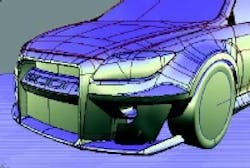Ideal software
Within StudioTools software, Five Axis sketched ideas and modeled surfaces for a Scion tC showcar's radical restyling.
Known for its wild concepts, Five Axis transformed this Scion tC into a mobile home theater complete with 43-in. plasma screen.
For the Scion tC showcar's interior, StudioTools software let Five Axis play around with different types of material and textures.
Prior to the Scion tC project, Five Axis used StudioTools software to turn this Scion xB Widebody into a rolling DJ stage.
Consumers often make product choices based on aesthetics, gravitating toward the "look" or "feel" of an item. Such purchasing habits force manufacturers to constantly revamp, improve, or just make their products different to stay competitive.
Success hinges on communicating new product ideas between industrial designers and engineers. To facilitate this communication, many manufacturers, especially those in the prototype and custom car industries, incorporate special industrial-design software that lets them quickly and effortlessly progress from initial 2D design sketches, to 3D modeling, to the CAD stage, and onto manufacturing. Five Axis Models of Huntington Beach, Calif., is one of those manufacturers.
The shop builds prototype cars working off existing designs from automotive design studios, which are its primary customers. However, about once a year, a major automotive company, in this case Scion, asks the shop to design and build a promotional show car.
Because the team at Five Axis have formal design training, Scion gave them free rein to produce something "crazy" with a Scion tC sport coupe. The only stipulation was the design had to reflect the car company's brand image.
Five Axis didn't just slap on a bunch of aftermarket custom parts. It reworked the car's look and transformed it into a mobile home theater, complete with 43-in. plasma video screen and accompanying audio system.
At the touch of a remote-control button, the car's rear hatch rises as the plasma screen simultaneously slides up into position. In unison, audio midrange speakers pivot upward, and subwoofer ones project forward under the screen.
The Five Axis team created the tC's radical styling using StudioTools software from Alias Systems of Toronto. Starting with production body files, the team sketched its ideas in the software, moved into rendering, and then developed surfaces.
StudioTools aided in the redesigning of all the exterior body panels, including the front and rear fenders, front and rear bumpers, quarter panels, and rocket rocker panels. It also played a major role in engineering the vehicle's interior for the home theater.
Opting to abandon the typical overplayed spoilers found on vehicle trunk lids, Five Axis suspended the car's aerodynamics from its lower portions. For the interior, finishes such as aluminum, carbon fiber, and acrylic present an industrial/architectural flavor.
Once the tC's Formula 1-inspired body data was complete, Five Axis machined molds for them on a CNC mill. The team then laminated the molds with fiberglass and carbon fiber to produce final parts.
Alias software is not a CAD product, but does create 3D models. It supports the creative process by providing integrated 2D-sketching capabilities for cranking out numerous ideas at the styling stage of product development. These sketches then allow for 3D modeling.
Such digital sketching gives shops like Five Axis flexibility and freedom to create, change, or delete lines and features.
In addition, the software's modeling techniques mirror those of physically modeling in clay. It doesn't eliminate the need for clay models, widely used in automotive design, but does limit having to make one for every design change.
Surface-model data created in Alias software transfers to CAD systems where engineers continue working the design for production. The process also works in the opposite direction, allowing engineers to import CAD data into StudioTools for sketching and creating surface models around that data.
With the software's visual tools, designers can jump ahead in time prior to manufacturing and add realistic materials, or combinations of materials, to their designs. The look of plastics, woods, and metals, along with color studies, are achievable, typically by importing real-life photos of various textures and materials into the software.
The tC wasn't the first wild car Five Axis built for Scion using StudioTools software. Prior to the home-theater concept, it turned a Scion xB Widebody into a rolling DJ stage.
Riding on a linear-actuator motor, a DJ platform slides out from the car's rear end, and a micro-switch activates a two-tiered rack housing DJ equipment. The DJ then manually pulls a top rack containing two turntables forward into position, along with a bottom rack that has two digital turntables and a mixer.
Equipped with both mid and high-range speakers, the car's rear doors, powered by linear actuators, open simultaneously with the rear tailgate. The car's rear cabin houses subwoofer speakers.
For more information on recreational manufacturing...visit americanmachinist.com
GM'S Global Design CenterGeneral Motors is leveraging the combined talents of its designers worldwide in essentially one virtual global design center. As part of the effort, Alias Systems plays key roles in several aspects, including optimizing the operation and management of design collaboration and visualization, data-quality assurance, 3D-data evaluation, and overall workflow enhancements. On the software side, GM design centers worldwide use Alias's PortfolioWall package. This collaboration tool assists in management-review processes, simplifies organizing and interactively presenting designs, and helps managers and executives easily review work in progress. Alias is also enhancing its AutoStudio package that GM uses as its standard conceptual design 3D modeling and rendering software. With this enhanced version, GM designers and sculptors access engineering data from a centralized, global source. The software links with UGS CAD and data-management processes. According to Terry Kline, an information officer at GM, Alias contributes a lot to GM's design visualization and workflow success. It lets GM's concept design and technical-surfacing teams work fast and efficiently, with an emphasis on design rather than software applications. |
